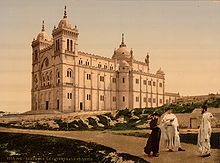Carthage Cathedral
The Cathedral of Saint Louis of Carthage ( Arabic كاتدرائية القديس لويس; French Cathédrale Saint-Louis de Carthage ) is a former Christian church building in the city of Carthage in Tunisia .
history
The initiative to build a cathedral in Carthage came from Cardinal Charles Martial Lavigerie , who was appointed Archbishop of Carthage and Primate of the Roman Catholic Church of All Africa in 1884 . Tunisia had been under French protectorate since 1881 , but as early as 1830 the French consul general in Tunis had received permission from Husain II. Bey to build a Christian house of worship. The cathedral, in the Byzantine-Moorish style, was built on the Byrsa hill of Carthage, on which the Acropolis of the Punians was believed to have been, right next to the foundation of a temple dedicated to Asclepius . The site of the tent of the French King Louis IX was also found there. of the saint (Saint Louis) , where he died on August 25, 1270 during the Seventh Crusade . The cathedral, completed in 1890, was consecrated to him and his entrails, venerated as relics , which Cardinal Lavigerie had acquired from King Francis II of Sicily , found their new repository here.
After his death in 1892, Cardinal Lavigerie was buried in the cathedral. After Tunisia gained independence in 1956, the relics of St. Louis were transferred to Paris ( Sainte-Chapelle ), and after the Roman Church handed the building over to the Tunisian state in 1964, the cardinal's body was transferred to Rome. After the building had not been used since 1964, it was given a new function in 1994 as a cultural meeting place (acropolium) and museum.
Web links
Coordinates: 36 ° 51 ′ 13.6 ″ N , 10 ° 19 ′ 24 ″ E

